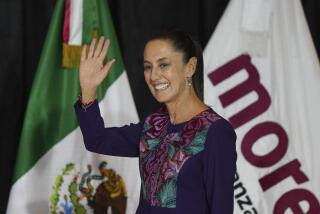Economic Data Show Mexico Still Struggling for Growth
- Share via
MEXICO CITY — Mexico’s economy grew a sluggish 3% last year, the government announced Wednesday, marking one of the worst showings in Latin America and another disappointing year for a country that many analysts say should be expanding twice as fast.
Gross domestic product, the country’s output of goods and services, increased a modest 2.7% in the fourth quarter over the same period a year earlier. Officials blamed the lackluster showing largely on fallout from hurricanes that battered the tourist magnet Cancun and farming areas in the south.
But analysts said Mexico’s economic doldrums couldn’t be blamed on a passing storm. The nation ended 2005 as it did many years during the last decade, with GDP growth among the lowest in the Western Hemisphere and far off the pace of rival emerging economies in Asia. The country’s perennial underachievement in growth and employment has surfaced as the biggest challenge facing the candidates in this year’s presidential election.
Mexico isn’t generating anywhere near the 1 million jobs it needs each year to keep up with population growth. Illegal emigration to the U.S. is believed to be at an all-time high. And China is grabbing market share in the U.S., the destination for more than 90% of Mexico’s exports.
What’s more, Mexico is underperforming at a time when many factors should be working in its favor, notably a sound U.S. economy, high prices for its crude oil, record remittances from Mexicans living abroad and its lowest inflation rate in years.
Although there is disagreement among policymakers and analysts on what needs to be done, nearly all concur that Mexico is fast losing competitiveness and that changes are needed to roust Latin America’s second-largest economy from its funk.
“What they need to get a leg up on growth is serious structural reform,” said economist Suhas Ketkar, a Latin American specialist at RBS Greenwich Capital Markets in Connecticut. He cited Mexico’s “rigid” labor rules, inadequate tax collection and government-controlled energy markets among the areas the country must address to boost income and efficiency.
Mexico isn’t alone in falling well short of its potential. Latin America has posted anemic economic growth for two decades.
While China experienced annual per-capita growth of about 8.5% from 1981 to 2000, Latin America’s per-capita GDP declined 0.7% during the 1980s and increased only about 1.5% a year in the 1990s, according to a new study by the World Bank. As a result, poverty rates in Latin America have barely budged, and only sub-Saharan Africa is saddled with a wider gulf between its rich and poor.
The economies of several Latin American countries have improved in recent years, thanks largely to skyrocketing commodity prices fueled by rising Chinese demand. Chile’s copper exports to the Asian giant have exploded, for example, as have Brazil’s shipments of soybeans.
But Mexico is struggling with the Chinese challenge. Low-cost goods have flooded its consumer markets, costing Mexico thousands of jobs in the textile, toy and electronics industries. In return, China buys virtually nothing from Mexico. Mexico’s trade deficit with China topped $14 billion last year.
But Mexico’s biggest concern is its slipping U.S. market share. In 2003, China surpassed Mexico to become the second-largest supplier of goods to the U.S., behind Canada. China’s share of U.S. imports rose to 14.6% last year, up from 8.2% in 2000. During the same period, Mexico’s share slipped a percentage point to 10.2%.
Some industry leaders here argue that China’s undervalued currency and government subsidies give its firms an unfair advantage. But many analysts fault Mexico.
“It’s not that China is crowding Mexico out. Mexico is crowding itself out by failing to pass structural reforms,” said Christian Stracke, emerging market analyst with New York-based CreditSights.
Mexico’s two leading presidential candidates differ markedly on how they would jump-start growth and employment.
Populist front-runner Andres Manuel Lopez Obrador of the Democratic Revolution Party favors public works projects to stimulate construction and related industries as well as social programs to help tens of millions of impoverished Mexicans.
Conservative National Action Party candidate Felipe Calderon supports the free-market solutions of the current president, Vicente Fox. They include opening the state-controlled oil and electricity markets to private investment.
No matter who wins, said Alberto Ramos, senior economist with Goldman Sachs in New York, “what we need now is for the political class to step up to the plate and face the challenge.”
More to Read
Sign up for Essential California
The most important California stories and recommendations in your inbox every morning.
You may occasionally receive promotional content from the Los Angeles Times.










